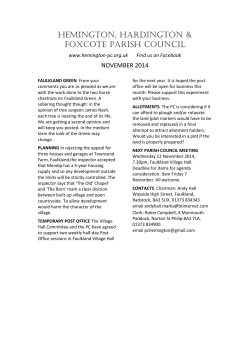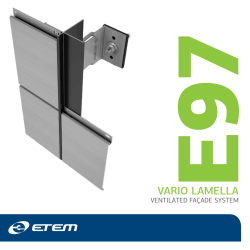
Fema Height Study - Village of Southampton
Village of Southampton FEMA Study Preliminary Recommendations Presentation to the Village Planning Commission January 7, 2015 Introductory Remarks “All coastal communities share a hardship of adaptation adaptation and balance of community character against the health, safety & welfare standards of building and local codes in flood zones which are enacted to reduce loss of life and property. The purpose of this Study is to provide guidance to the Village to maintain balance of community character with the increasing risks of building within flood zones.” Background • Flood Zones defined by 2009 FEMA mapping (updated since 1983 standard) • New construction must be designed to meet or exceed coastal construction standards • Changed Base Flood Elevation (BFE) – in some cases dramatically • Need for solutions which preserve character of the community Project Approach • Define Study Area Boundary (Map of Lots within Flood Zones) • Review Available Maps, Literature/Data, Correspondence, Building Department Files, FEMA Requirements • Field Investigations • Inventory & Analyze Existing Conditions • Interviews Project Approach (continued) • Evaluation of Permit Application Submission Requirements • Assessment of Application and Permit Procedures • Review of Research State Building Code, National Reference Standards, & Zoning Codes of Other Local Communities • (Villages of East Hampton, Westhampton Beach, Westhampton Dunes & Sagaponack) • (Towns of Southampton, East Hampton, & Brookhaven) • Compile, Analyze, and Formulate Approach • Identify Potential Solutions Study Area FEMA Flood Zones in the Village of Southampton Input Received Input from: • Mayor • Chief Building Inspector • Village Attorney • Representatives from: Common Issues/Concerns: • • Planning Commission • ARB • ZBA • Southampton Association Height of Buildings in Flood Zones (Actual and Perceived) • Inadequate Screening • Excessive Impervious Surface • Flooding and Drainage Issues • Need to Refine/Streamline Application Process • 2 ½ to 3½ story façades • Bulk & Massing of Homes (Actual & Perceived - especially on small lots) • Difficulty with Style of Home versus Perception of Height & Massing • “Loopholes” & “Gray Areas” in Code • On-site Parking Issues Loss of Privacy from Upper Floors - View Looming over Neighboring Homes & Yards • Differences between Ocean, Bay, & Pond lots • Protection of Property Development Rights • FEMA / Flood Zone Basics • Purpose of FEMA/ FIRM Maps - NFIP • Changes to FEMA/ FIRM Maps • • • Change in how sea level is calculated Change in National Vertical 1988 Datum Change of understanding characteristics of wave action, wave run-up, accretion, and the effect of new inlets on bay water wave (incoming and receding waves) • Compliance with FEMA, ASCE 24-05 and State Building Code • Existing Village Policy (BFE +2) - as required by above FEMA Zones & Base Flood Elevations (Example of historic versus current) AE: El 8 AE: El 14 General Comparison of Height Limits in Other Municipalities Municipality Village of Southampton Maximum Height Upland In Flood Zones 35' with Sky Plane for R7.5 to R-20 Zones 35' from BFE +2 32' with Sky Plane 32' measured from natural grade Town of East Hampton 32' with Sky Plane 32' measured from natural grade Village of Sagaponack 32' with Sky Plane max. 40' above sea level Village of East Hampton Analysis • No single solution - need a comprehensive approach • Interrelationship of Issues / providing a “Whole Project” Design Solution • FEMA Elevations Site Grading/Fill • The solution is in the Management of Building Features and Façade Articulation • Building Massing • Building Height • Roof Types Analysis • No single solution - need a comprehensive approach • Interrelationship of Issues / providing a “Whole Project” Design Solution • FEMA Elevations Site Grading/Fill • The solution is in the Management of Building Features and Façade Articulation – with goal of reduced perceived massing and height • Building Massing • Building Height • Roof Types Analysis • No single solution - need a comprehensive approach • Interrelationship of Issues / providing a “Whole Project” Design Solution • FEMA Elevations Site Grading/Fill • The solution is in the Management of Building Features and Façade Articulation – with goal of reduced perceived massing and height • Building Massing • Building Height • Roof Types Analysis • No single solution - need a comprehensive approach • Interrelationship of Issues / providing a “Whole Project” Design Solution • FEMA Elevations Site Grading/Fill • The solution is in the Management of Building Features and Façade Articulation – with goal of reduced perceived massing and height • Building Massing • Building Height • Roof Types Analysis • No single solution - need a comprehensive approach • Interrelationship of Issues / providing a “Whole Project” Design Solution • FEMA Elevations Site Grading/Fill • The solution is in the Management of Building Features and Façade Articulation – with goal of reduced perceived massing and height • Building Massing • Building Height • Roof Types Potential Solutions • • • • Establish Uniform Measurement of Building Height Require Minimum Roof Pitch Requirements Pyramid / Sky Plane Law (With Allowances for Architectural Features) Develop Façade Articulation Requirements / Improve Definition of ‘Stories’ / Vertical & Horizontal Dimensional Restrictions • Form-based Option Potential Solutions (continued) • • • • Restrict Side Yard and Front Yard Grading for Flood Water (Recharge & Flow) Restrictions on Maximum Impervious Surface Coverage Limit Areas Where Grade May be Modified (i.e. slopes, berms, retaining walls) Adoption of and Enforcement of Floodplain Management Construction Methodology Recommendations Uniform Measurement of Building Height • 1 foot above the BFE Flood Zone requirement • Measurement of building height from the Grade Plane (35 Ft) • Equalizes how homes are measured in/out of the Flood Zone Regulating Mass • New and modified definitions • Min. roof pitch – steeper is better for sightlines • Half stories – revised to reduce size of 3rd floor • Façade articulation – reduces ‘single mass’ of large walls & volumes • Combination of all suggestions reduce overall building height & allow highest points to be in the center of the property rather than at edges. Sky Plane (Pyramid Law) • Reduces the height of portions of buildings closest to the public and neighbors, forcing stepped volumes and more architectural interest. • Different dimensional methodology to address different conditions Sky Plane (Pyramid Law) • Bayside fronting properties have shallow lots, no dune system and is the first to flood. • Locating homes closer to the street on shallow lots is advantageous for community floodplain management. Sky Plane (Pyramid Law) • Utilizing Sky Plane, reduction of large volumes closest to the neighboring properties and community. • Solves concerns regarding privacy, particularly for narrow lots Façade Articulation (Example Without and With a Façade Break) Two Examples of Side Façade Articulation of Upper Floors Drainage/Flooding • Limit impervious surfaces (in front & side yards) • Limit use of non-structural fill (in front & side yard areas) • Maximum slope for non-structural fill • Limit use of retaining walls & berms Drainage/Flooding Cumulative Analysis of Issues & Recommendations Recommendations Grade Plane Pyramid Law Building Height -- Building Mass Building Setbacks -- -- -- Site Grading/Fill -- -- -- Issues Façade Architectural Articulation Features Side Yard Grading A “” indicates those issues that can be addressed by implementation of the recommendation Additional Items to be Considered On-site Parking Floodplain Management Standards (i.e.: Drainage, Flooding, Fill) Planting & Screening Maximum Slope over Drainage and Septic Systems (5%) ‘Flood-proof ’ Sanitary Systems from Discharging onto Roads & Adjacent Properties During Floods • Retaining Wall / Berm Standards & Certification of Design to Resist Scour, Floodplain Structure/ Structural standards • Uniform and Predictable Standards of Applications and Documents • • • • • Next Steps • Consider Input on Recommendations & Revise as Appropriate • Address Application Submission and Procedural Requirements (uniform predictability and consistency of review process solutions, forms, diagrams, surveying standards, submission standards & checklists, & application procedures) • Complete Project Tasks • Prepare Draft Report • Present Recommendations to Village Trustees Q&A Please direct written comments by the close of business January 30, 2015 to: Stephen Funsch, Village Administrator Village of Southampton 23 Main Street Southampton, NY 11968 Email: Fax: villageadmin@southamptonvillage.org 631-283-4990
© Copyright 2025











